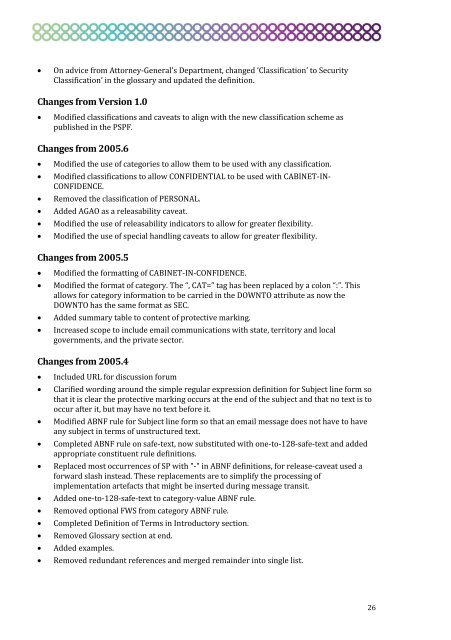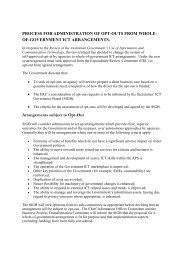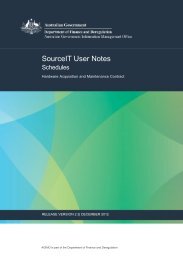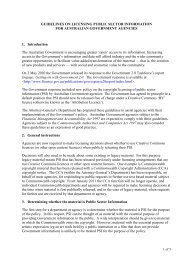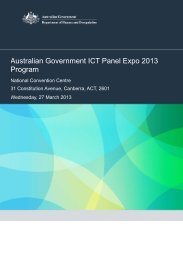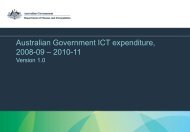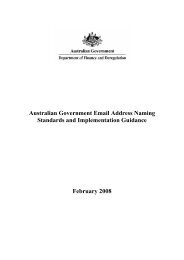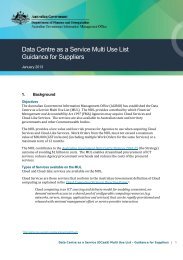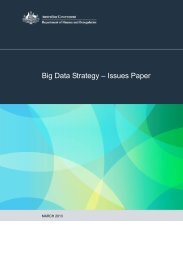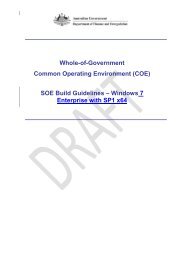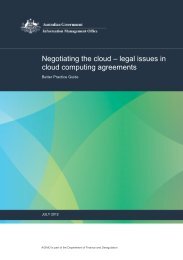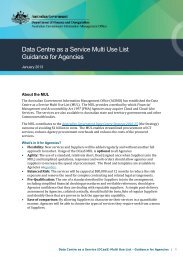Email Protective Marking Standard for the Australian Government
Email Protective Marking Standard for the Australian Government
Email Protective Marking Standard for the Australian Government
You also want an ePaper? Increase the reach of your titles
YUMPU automatically turns print PDFs into web optimized ePapers that Google loves.
On advice from Attorney-General’s Department, changed ‘Classification’ to SecurityClassification’ in <strong>the</strong> glossary and updated <strong>the</strong> definition.Changes from Version 1.0Modified classifications and caveats to align with <strong>the</strong> new classification scheme aspublished in <strong>the</strong> PSPF.Changes from 2005.6Modified <strong>the</strong> use of categories to allow <strong>the</strong>m to be used with any classification.Modified classifications to allow CONFIDENTIAL to be used with CABINET-IN-CONFIDENCE.Removed <strong>the</strong> classification of PERSONAL.Added AGAO as a releasability caveat.Modified <strong>the</strong> use of releasability indicators to allow <strong>for</strong> greater flexibility.Modified <strong>the</strong> use of special handling caveats to allow <strong>for</strong> greater flexibility.Changes from 2005.5Modified <strong>the</strong> <strong>for</strong>matting of CABINET-IN-CONFIDENCE.Modified <strong>the</strong> <strong>for</strong>mat of category. The “, CAT=” tag has been replaced by a colon “:”. Thisallows <strong>for</strong> category in<strong>for</strong>mation to be carried in <strong>the</strong> DOWNTO attribute as now <strong>the</strong>DOWNTO has <strong>the</strong> same <strong>for</strong>mat as SEC.Added summary table to content of protective marking.Increased scope to include email communications with state, territory and localgovernments, and <strong>the</strong> private sector.Changes from 2005.4Included URL <strong>for</strong> discussion <strong>for</strong>umClarified wording around <strong>the</strong> simple regular expression definition <strong>for</strong> Subject line <strong>for</strong>m sothat it is clear <strong>the</strong> protective marking occurs at <strong>the</strong> end of <strong>the</strong> subject and that no text is tooccur after it, but may have no text be<strong>for</strong>e it.Modified ABNF rule <strong>for</strong> Subject line <strong>for</strong>m so that an email message does not have to haveany subject in terms of unstructured text.Completed ABNF rule on safe-text, now substituted with one-to-128-safe-text and addedappropriate constituent rule definitions.Replaced most occurrences of SP with "-" in ABNF definitions, <strong>for</strong> release-caveat used a<strong>for</strong>ward slash instead. These replacements are to simplify <strong>the</strong> processing ofimplementation artefacts that might be inserted during message transit.Added one-to-128-safe-text to category-value ABNF rule.Removed optional FWS from category ABNF rule.Completed Definition of Terms in Introductory section.Removed Glossary section at end.Added examples.Removed redundant references and merged remainder into single list.26


